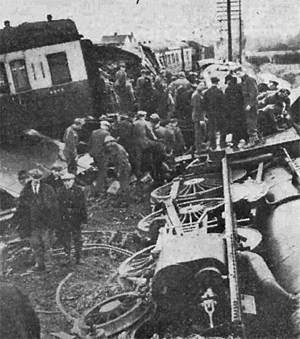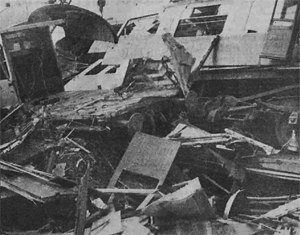| Today marks the anniversary of a serious accident on the Great Western Railway at Norton Fitzwarren in 1940. 27 people were killed, and a further 75 were injured when their express sleeper train from London (carrying over 900 people) passed two signals at danger, derailed and overturned. The accident occurred at about 3.45 a.m. on a very dark, wet and windy night. The train had been routed from the main line to a relief line at Taunton, to allow another train (carrying newspapers) to pass. However, the driver was under the impression that he was still on the main line and continued to accelerate until he realised his error. By that time it was too late to bring the train to a halt. The train went through a set of catch points at about 45 mph (there to protect the main line). The locomotive tipped onto its side and the first six coaches telescoped into each other, blocking all four tracks. Luckily, the newspaper train had just passed the express - had the two trains collided the casualties would have been far greater. The causes of the accident still feature in rail accidents today. The driver, with over 40 years' experience, was probably operating on 'auto-pilot' - his experience worked against him as his actions became subconscious; including cancelling two warnings from the automatic signalling system. He had also lost his 'situational awareness', being unaware of which line he was running on; he had never before been diverted onto this line and the signals that applied to him were on the opposite side of the track from normal practice. Fatigue and other psychological factors were also likely to be present; the train was working during wartime blackout conditions, during the night and his home in London had recently been damaged by bombing. You can read the accident report on the Railways Archive website, and the story is told in detail in this contemporary newspaper report. |
|
9 Comments
Amyas Crump
4/11/2014 03:36:53 pm
Such a shame that the Driver keeps getting the sole blame. It has been published that West Station signalman later admitted reversing the signals, but was not even questioned because he was a JP. It has also been shewn to be likely that a second signalman did the same before the train reached Norton Fitzwarren. The line here is on an embankment, so the stories about the Driver wading through waist deep floodwater, are also ill-informed. Driver Stacey never went back on the mainline after this, nor would he talk about it, but he was treated very harshly.
Reply
Albert Batten
9/5/2018 10:02:34 am
The driver certainly was treated disgracefully. He died a year later from a medical condition. Would never talk about the accident in that time. The signalman actually changed the route whilst the train was waiting at Taunton. Nobody thought to tell the driver this and that is the key point that never came out in the inquiry. After travelling that route countless times of course he would be expecting his normal route. He should have been told.
Reply
Ian Wilson
22/11/2018 07:56:33 pm
My father Andrew S Wilson RN was an injured passenger on the train, my mum was a nurse in the hospital where he was sent, they met and the rest is history.
Reply
Silver Moor
23/11/2018 12:35:47 pm
Thanks Ian; great story to add to what we've found out. Our research had found your father's name on the list of injured. He was recorded as being 25 at the time of the accident and from Fife, Scotland.
Reply
Derek Marriott
25/4/2019 08:30:55 pm
As a Scouter at 1st Whimple Scout Group we had a very fine lady as a treasurer and great supporter of many local organisation. Mrs Frances Pratt was a nurse at a Taunton hospital during the war. Seldom mentioned things of the past, but only recently have we realised her was time exploits were very significant. A wonderful lady. DVM
Reply
michael gosling
28/4/2019 04:29:34 pm
In the contemporary newspaper report Charles A Davis is listed as possibly being the remaining unidentified dead sailor. This was indeed the case - he was my mother's brother. He was 23 years old and came from Oxford and is buried in a CWGC grave in the Rose Hill cemetery there..
Reply
Stephanie Morgan
25/11/2021 08:29:20 pm
My grandad was on the train travelling to see my Nan and my mum, who was only 9 and who had been evacuated. He was a policeman in London and sadly died in the tragic accident.
Reply
Silver Moor
25/11/2021 10:26:03 pm
There were three Met police officers on the train who died. All were on their way to visit families evacuated from London to Cornwall. Take a look at our larger article on the accident at https://www.silvermoorconsulting.co.uk/news/norton-fitzwarren-rail-disasters-november-1890-and-1940
Reply
Stephanie Morgan
25/11/2021 10:39:18 pm
My grandad was James William Rivett aged 44 and a serving met police officer, he was on his way to see my Nan and mum who had been evacuated to Cornwall. Your comment will be posted after it is approved.
Leave a Reply. |
Archives
November 2020
Categories
All
|



 RSS Feed
RSS Feed